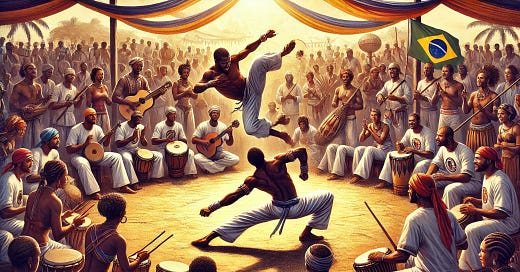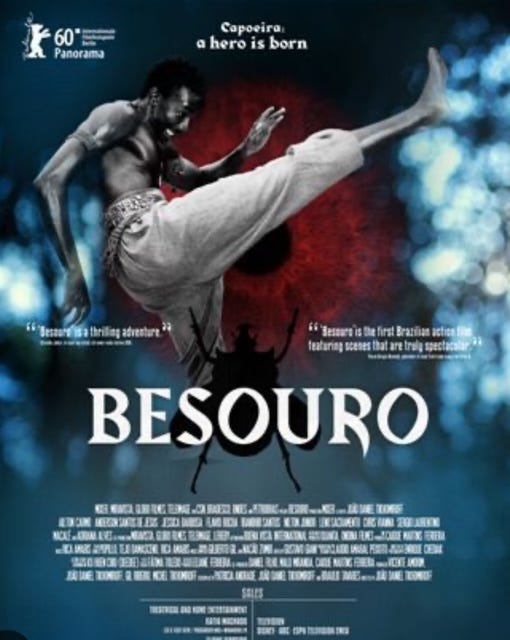Capoeira: The African Martial Art of Brazil – How Enslaved Africans Disguised Combat as Dance
Capoeira: From Enslaved Africans' Secret Combat to a Global Cultural Phenomenon
As always, if I can bring a visual to our topic, I will! One of my top 10 favorite African Diaspora films is Besouro (Black Beetle)—a powerful story about how Capoeira became a vital tool of resistance against the Portuguese.
If you haven’t seen it yet, here’s your chance to watch it for free on YouTube: 🎥 Watch Besouro here.
Capoeira is more than just movement—it’s a fusion of martial arts, dance, music, and resilience that allowed enslaved Africans in Brazil to protect themselves under the guise of cultural expression. This art form is a testament to the power of adaptation and resistance in the face of oppression.
If you’ve watched Besouro or any of the other films we’ve recommended, come back, share your thoughts, and comment! I’d love to hear how these stories have impacted you.
Obrigado (Thank you)! Xoxo 💛✨
Capoeira is more than just a martial art; it's a vibrant tapestry of history, culture, and resilience. Born from the ingenuity of enslaved Africans in Brazil, capoeira transformed from a clandestine form of self-defense into a celebrated global art form.
Facts About Capoeira: The African Martial Art of Brazil – How Enslaved Africans Disguised Combat as Dance
Capoeira is a unique Afro-Brazilian martial art that blends elements of dance, acrobatics, music, and spirituality. Developed by enslaved Africans in Brazil, it served as both a form of self-defense and a means of cultural expression.
1. Origins Rooted in African Traditions
Capoeira originated during the 16th century when enslaved Africans, primarily from Angola, were brought to Brazil by Portuguese colonizers. These diverse groups merged their cultural practices, leading to the development of capoeira as a method of resistance and survival.
2. Disguised as Dance to Evade Oppressors
To practice combat techniques without arousing suspicion, enslaved Africans disguised capoeira as a dance. This allowed them to train for self-defense while preserving their cultural identity.
3. The Roda: Capoeira's Performance Circle
Capoeira is traditionally performed in a roda, a circle formed by participants who sing, clap, and play instruments. Within this circle, two capoeiristas engage in a fluid game, showcasing their skills and improvisation.
4. Musical Elements Integral to Practice
Music is central to capoeira, guiding the game's rhythm and style. Instruments like the berimbau (a single-string percussion instrument), atabaque (drum), and pandeiro (tambourine) set the tempo, while songs convey stories and traditions.
5. Evolution Amidst Persecution
Throughout history, capoeira faced periods of prohibition and persecution, especially during the late 19th and early 20th centuries. Practitioners kept the art alive by adapting its practice and emphasizing its cultural aspects.
6. Mestre Bimba's Legalization Efforts
In the 1930s, Mestre Bimba played a pivotal role in legitimizing capoeira. He developed the Capoeira Regional style, incorporating elements from other martial arts and emphasizing discipline, which led to official recognition of capoeira as a cultural practice.
7. Capoeira's Global Spread
From its origins in Brazil, capoeira has gained international popularity. Today, it is practiced worldwide and celebrated for its cultural richness and physical artistry.
8. Recognition as Cultural Heritage
In 2014, UNESCO granted capoeira a special protected status as an intangible cultural heritage, acknowledging its significance in Afro-Brazilian history and culture.
9. Capoeira's Role in Identity and Resistance
Beyond its physical aspects, capoeira has served as a tool for cultural affirmation and resistance against oppression, helping practitioners connect with their heritage and assert their identity.
10. Modern-Day Practice and Community
Today, capoeira continues to evolve, encompassing elements of dance, music, history, and community engagement while remaining a symbol of resilience and cultural pride.
Why This Matters Today
Capoeira's history is a testament to the indomitable spirit of resistance and cultural preservation. By examining its roots and evolution, we gain insight into the broader narratives of oppression, adaptation, and resilience that continue to resonate in today's struggles for social justice and cultural identity.
✨ Join us as we delve into the rich legacy of capoeira and its enduring impact on communities around the globe.
📺 Watch on YouTube: https://www.youtube.com/@TadeOyeilumi
📩 Subscribe on Substack for More In-Depth Analyses: [https://substack.com/@oreofetadeoyeilumi?r=2ntabk&utm_campaign=profile&utm_medium=profile-page]
☕ Enjoying this content? Support my work by buying me a coffee! Your contribution fuels the research and storytelling that bring these important narratives to light.
🗣️ What fascinates you most about capoeira's history? Share your thoughts in the comments!






